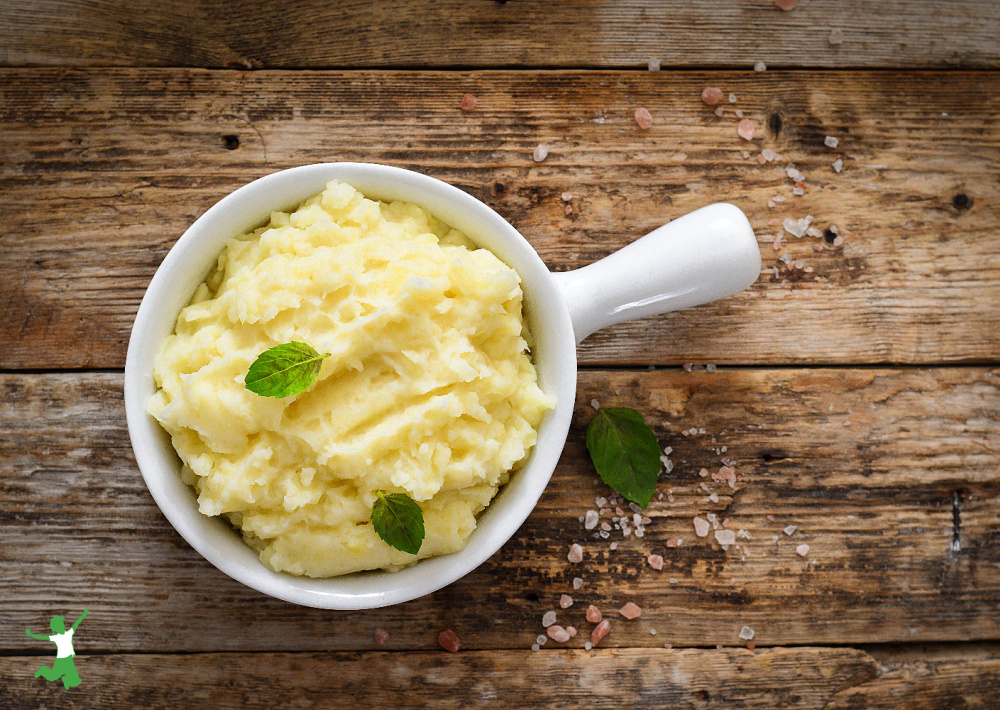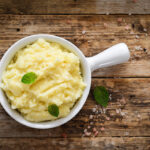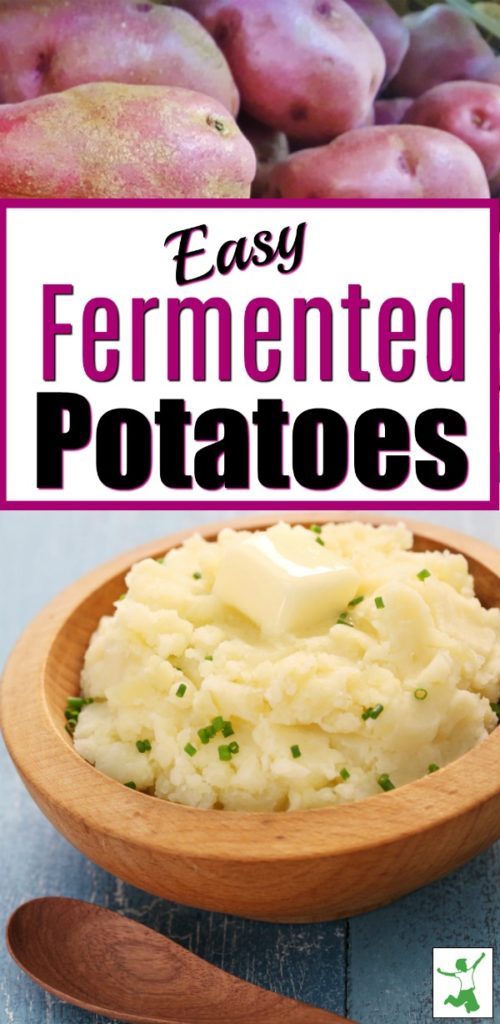Table of Contents[Hide][Show]
Traditional method for fermented potatoes as an enzyme-rich, cultured side dish that adds probiotics and resistant starch to the diet.

Is there anything quite as satisfying as mashed potatoes with dinner? I just love all forms of potatoes… baked, fried, mashed, even boiled!
This recipe provides a traditional method (with video how-to) for making fermented potatoes to add to your spuds repertoire.
Why would you want to make cultured potatoes in the first place? Because, unfortunately, the starch in potatoes is really not all that easy to digest for many people.
Especially these days with so many people suffering from digestive complaints of all kinds, starch can be a real pain…quite literally!
Potatoes are also nightshade vegetables, so lightly culturing them can help with any issues for those who are sensitive.
The problem is with the starch molecule itself. Each one is quite complex…comprised of hundreds of mono-sugars connected in long, branch-like strands.
It takes much digestive work to break down the starch molecule and, as a result, much of it goes undigested in most cases.
For those with an imbalanced gut, the undigested starch is the perfect food for pathogens and they grow and produce toxins that cause a variety of unpleasant symptoms in susceptible individuals.
Easy-to-Digest Cultured Potatoes
If you enjoy potatoes but find that they trigger digestive or autoimmune symptoms, it might be worth it for you to try your hand at fermenting them.
I prefer Yukon Gold as it seems to make the tastiest dish! Red or purple potatoes are also amazing.
If you are coming off the GAPS, AIP or SCD diets and reintroducing resistant starch to your diet after a period of gut healing, fermented potatoes would be a great first step.
While resistant starch is reduced during cooking, the bonds reform when the potatoes are cooled and these “new resistant starches” remain even if the dish is reheated before eating! (1)
We like this dish in our home to simply add that probiotic element to a meal of primarily cooked foods. Adding enzyme-rich, live food to your meals is nothing short of miraculous for boosting immunity and improving nutrient absorption.
If you’ve been wanting to make a fermented dish at home for the first time, this would be an easy and delicious one to start with!
The video demonstration included with the recipe below shows how to make probiotic potatoes using the Nourishing Traditions method.
If you are not eating white potatoes, feel free to substitute sweet potatoes instead.
Dairy-free? Try this fermented sweet potatoes recipe that uses sauerkraut juice instead of yogurt as the starter.

Fermented Potatoes Recipe
This recipe for fermented potatoes is an enzyme and probiotic-rich side dish that adds resistant starch that is more easily digested and shown to reduce belly fat.
Ingredients
- 4 cups white potatoes preferably organic
- 2 cups whole milk yogurt plain, preferably organic
- 1 Tbsp sea salt
Instructions
-
Peel the potatoes. This greatly reduces the chances of fermentation mold. Bake or boil potatoes and then mash them in a large glass bowl. Do not microwave.
-
With a handheld mixer or food processor, blend well with yogurt and sea salt once the potatoes are warm and no longer hot.
-
Cover with a clean, cotton cloth and secure with a rubber band. Leave the covered bowl on the counter for 2 days and then refrigerate. They will last about a month.
-
Serve with steak as an enzyme-rich side dish or with any meal where potatoes work well.
-
You may reheat cultured potatoes on the stove before serving, but take care not to warm them too much or enzymes and probiotics will be lost. Keep below 118 °F/ 48 °C.
Recipe Video

(1) Eat This Carb and You Won’t Gain Weight








Must the potatoes be mashed, or can they be diced for other things like potato salad?
I haven’t tried it with diced potatoes, but it probably would work. If you try it, please let us know how it turns out!
Does the process of cooking “re-animate” the starches? (and sugar?)
I’m a Type 2 Diabetic looking for a way to keep my carbs down, consume no sugar, and get some natural probiotics directly from food.
I recently read a post saying that cooking fermented potatoes will lead to the fiber breaking down into sugar:
I just read another post on fermenting potatoes, particularly:
https://drdavisinfinitehealth.com/2018/02/fermented-raw-potato/
It states that all benefits of low/no carbs is REMOVED if the potatoes are COOKED, and that cooking will lead to the breaking down into SUGAR.
“Because they are raw, there are zero net carbs but plenty of fiber. (When heated, however, fibers depolymerize or break down into sugars. When raw and unheated, fibers remain in polymer form.)”
That means that although these might be good for you, cooking will destroy the benefits for a Type 2 diabetic.
Your thoughts??
When the potatoes cool, the resistant starch is re-activated so to speak. If you warm the potatoes before eating, do so lightly to avoid harming the probiotic content as well as the resistant starch.
Hi, thank you for the recipe. I am wondering if the salt destroys the beneficial enzymes present in the yoghurt?
Thanks for all your good work!
The sea salt does not harm the beneficial microbes in the yogurt 🙂
INCREDIBLY GRATEFUL FOR THIS RECIPE!!! Thank you kindly!
Hello, Could a vegan yogurt be used for the fermented potatoe recipe in place of the milk yogurt?
Here are your options for culturing without whey (vegan yogurt won’t work … it is full of additives and not probiotically active as it isn’t fermented very long).
https://www.thehealthyhomeeconomist.com/dairy-free-fermentation-no-whey/
Let us know if you try one of these non-dairy starter methods with this particular recipe.